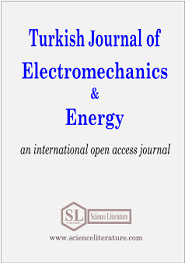
Effect of silicon ratio and sheet thickness on energy efficiency of induction motor
Abstract
Electric machines consume a large portion of electricity in industry and daily life. To minimize energy consumption, it is necessary to increase the performance of electrical machines. There are three key factors influencing the energy efficiency of transformers and electric motors. Electrical steels, also known as silicon steel sheets, are widely used as core materials in electric motors, transformers, and generators. The silicon ratio of electrical steel has a crucial role in energy efficiency. In this study, a finite element model was used to observe the effect of silicon ratio and sheet thickness on motor efficiency. In the finite element model, M27, M36, and M43 core materials were employed in varying thicknesses (e.g., 0.36, 0.47, and 0.64). M43 silicon steel had the lowest electric motor efficiency, measuring 83.19%, whereas M27 silicon steel demonstrated the maximum efficiency, measuring 84.24%. An improvement in energy efficiency of 1.05% was found in the study's results. The results of the study indicated that motor efficiency could be increased by optimizing the thickness and silicon ratio of the silicon steel sheets.
Full Text:
PDFReferences
Konda Y.R., Ponnaganti V.K., Reddy P.V.S., Singh R.R., Mercorelli P., Gundabattini E., Solomon D.G, “Thermal Analysis and Cooling Strategies of High-Efficiency Three-Phase Squirrel-Cage Induction Motors—A Review,” Computation, 12(1), pp. 6, 2024.
Ocak C., “A FEM-based comparative study of the effect of rotor bar designs on the performance of squirrel cage induction motors,” Energies, 16(16), pp. 6047, 2023.
E. Mazaheri-Tehrani and J. Faiz, “Airgap and stray magnetic flux monitoring techniques for fault diagnosis of electrical machines: An overview”, IET Electr. Power Appl., 16(3), pp. 277-299, 2022
A. Krings, “Iron losses in electrical machines - Influence of material properties, manufacturing processes, and inverter operation,” PhD dissertation, KTH Royal Institute of Technology, Stockholm, Sweden, 2014.
S. Okamoto, N. Denis, Y. Kato, M. Ieki, and K. Fujisaki, “Core loss reduction of an interior permanent-magnet synchronous motor using amorphous stator core,” IEEE Trans. Ind. Appl., 52(3), pp. 2261–2268, 2016.
R. Saidur, “A review on electrical motors energy use and energy savings,” Renew. Sustain. Energy Rev., 14(3), pp. 877–898, 2010.
Y. L. Karnavas and I. D. Chasiotis, “Influence of soft magnetic materials application to squirrel cage induction motor design and performance,” Eng. J., 21(1), pp. 193–206, 2017.
D. F. de Souza, F. A. M. Salotti, I. L. Sauer, H. Tatizawa, A. T. de Almeida, and A. G. Kanashiro, “A performance evaluation of three-phase induction electric motors between 1945 and 2020,” Energies, 15(6), p. 2002, 2022.
O. Toirov, N. Tursunov, S. Alimukhamedov, and L. Kuchkorov, “Improvement of the out-of-furnace steel treatment technology for improving its mechanical properties,” in E3S Web of Conferences, 22-24 August 2023, Tashkent, Uzbekistan, EDP Sciences2023. p. 05002.
Y. Du, R. O’Malley, and M. F. Buchely, “Review of magnetic properties and texture evolution in non-oriented electrical steels,” Appl. Sci., 13(10), p. 6097, 2023.
V. Goel, P. Anderson, J. Hall, F. Robinson, and S. Bohm, “Electroless Co–P-Carbon Nanotube composite coating to enhance magnetic properties of grain-oriented electrical steel,” J. Magn. Magn. Mater., vol. 407, pp. 42–45, 2016.
G. Ouyang, X. Chen, Y. Liang, C. Macziewski, and J. Cui, “Review of Fe-6.5 wt%Si high silicon steel—A promising soft magnetic material for sub-kHz application,” J. Magn. Magn. Mater., vol. 481, pp. 234–250, 2019.
M. Goertz, “Iron‐Silicon Alloys Heat Treated in a Magnetic Field,” J. Appl. Phys., 22(7), pp. 964–965, 1951.
Y. Oda, M. Kohno, and A. Honda, “Recent development of non-oriented electrical steel sheet for automobile electrical devices,” J. Magn. Magn. Mater., 320(20), pp. 2430–2435, 2008.
K. Tolle and N. Marheineke, “Extended Group Finite Element Method,” Appl. Numer. Math., 162, pp. 1-19, 2021.
M. Tandoğan., Ö. Eyercioğlu., M. Dülger., "Principles and finite element simulation of multi-point forming technology for sheet metal," TIJMET, 3(2), pp.120-130, 2020.
M. Morimoto, “Induction motor made of iron powder core,” in The 2010 International Power Electronics Conference-ECCE ASIA-, 21-24 June 2010, Sapporo, Japan, pp. 1814–1817.
G. Stornelli et al., “Properties of additively manufactured electric steel powder cores with increased Si content,” Materials (Basel)., 14(6), p. 1489, 2021.
D. Hawezy, " The influence of silicon content on physical properties of non-oriented silicon steel," Mater. Sci. Technol., 33(14), pp 1560-1569, 2017.
N. F. Yılmaz, M. Y. Dulkadir, M. Yılmaz, M. F. Kalkan, "Modelling of Energy Efficiency in Electric Motors Using the Finite-Element Method" in Proc. of The International Conference of Materials and Engineering Technology, 05-07 November 2020, Gaziantep, Turkey. Available: https://www.ticmet.org.
A. Deshmukh and M. Bhutada, “Three Phase Induction Motor-Model Design and Performance Analysis in ANSYS Maxwell,” Int. Res. J. Eng. Technol., 8(4), pp. 3125–3131, 2021.
C.A. Cezario, M. Verardi, S.S. Borges, J.C. Silva, A.A.M. Oliveira “Transient Thermal Analysis Of An Induction Electric Motor,” in Proc. of 18th International Congress of Mechanical Engineering, 06-11 November 2005, Ouro Preto, MG. Available: https://www.researchgate.net/publication/228893825_Transient_thermal_analysis_of_an_induction_electric_motor
J. Kartigeyan and M. Ramaswamy, “Effect of material properties on core loss in switched reluctance motor using non-oriented electrical steels,” J. Magn., 22(1), pp. 93–99, 2017.
S.-H. Chai, J.-H. Kim, S.-I. Kim, and J.-P. Hong, “Extrapolating B–H curve data using common electrical steel characteristics for high magnetic saturation applications,” J. Magn., 20(3), pp. 258–264, 2015.
G. Dong and O. Ojo, “Efficiency optimizing control of induction motor using natural variables,” IEEE Trans. Ind. Electron., 53(6), pp. 1791–1798, 2006.
D. A. Gonzalez and D. M. Saban, “Study of the copper losses in a high-speed permanent-magnet machine with form-wound windings,” IEEE Trans. Ind. Electron., 61(6), pp. 3038–3045, 2013.
M. Oka, M. Enokizono, Y. Mori, and K. Yamazaki, “Magnetic characterization of the stator core of a high-speed motor made of an ultrathin electrical steel sheet using the magnetic property evaluation system,” AIP Adv., 8(4), 2018.
T. Sato and M. Enokizono, "Evaluation of stator core loss of high-speed motor by using thermography camera," AIP Adv., 8(4), 2018.
G. Bucci, , F. Ciancetta, E. Fiorucci, and A. Ometto, “Uncertainty issues in direct and indirect efficiency determination for three-phase induction motors: remarks about the IEC 60034-2-1 standard,” IEEE Transactions on Instrumentation and Measurement, 65(12), pp. 2701-2716, 2016.
URN: https://sloi.org/urn:sl:tjoee92322
Copyright (c) 2024 Turkish Journal of Electromechanics and Energy

This work is licensed under a Creative Commons Attribution-NonCommercial 4.0 International License.

 Indexed in:
Indexed in:
















